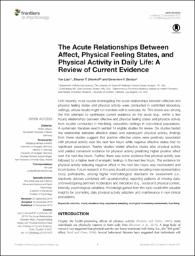
ATTENTION: The works hosted here are being migrated to a new repository that will consolidate resources, improve discoverability, and better show UTA's research impact on the global community. We will update authors as the migration progresses. Please see MavMatrix for more information.
Show simple item record
| dc.contributor.author | Liao, Yue | |
| dc.contributor.author | Shonkoff, Eleanor T. | |
| dc.contributor.author | Dunton, Genevieve F. | |
| dc.date.accessioned | 2021-06-28T17:45:57Z | |
| dc.date.available | 2021-06-28T17:45:57Z | |
| dc.date.issued | 2015-12-23 | |
| dc.identifier.issn | 1664-1078 | |
| dc.identifier.uri | http://hdl.handle.net/10106/29941 | |
| dc.description.abstract | Until recently, most studies investigating the acute relationships between affective and physical feeling states and physical activity were conducted in controlled laboratory settings, whose results might not translate well to everyday life. This review was among the first attempts to synthesize current evidence on the acute (e.g., within a few hours) relationships between affective and physical feeling states and physical activity from studies conducted in free-living, naturalistic settings in non-clinical populations. A systematic literature search yielded 14 eligible studies for review. Six studies tested the relationship between affective states and subsequent physical activity; findings from these studies suggest that positive affective states were positively associated with physical activity over the next few hours while negative affective states had no significant association. Twelve studies tested affective states after physical activity and yielded consistent evidence for physical activity predicting higher positive affect over the next few hours. Further, there was some evidence that physical activity was followed by a higher level of energetic feelings in the next few hours. The evidence for physical activity reducing negative affect in the next few hours was inconsistent and inconclusive. Future research in this area should consider recruiting more representative study participants, utilizing higher methodological standards for assessment (i.e., electronic devices combined with accelerometry), reporting patterns of missing data, and investigating pertinent moderators and mediators (e.g., social and physical context, intensity, psychological variables). Knowledge gained from this topic could offer valuable insights for promoting daily physical activity adoption and maintenance in non-clinical populations.[Copyright © 2015 Liao, Shonkoff and Dunton. This is an open-access article distributed under the terms of the Creative Commons Attribution License (CC BY). The use, distribution or reproduction in other forums is permitted, provided the original author(s) or licensor are credited and that the original publication in this journal is cited, in accordance with accepted academic practice. No use, distribution or reproduction is permitted which does not comply with these terms. Available online: https://doi.org/10.3389/fpsyg.2015.01975] | en_US |
| dc.language.iso | en_US | en_US |
| dc.publisher | Frontiers Media | en_US |
| dc.relation.ispartofseries | Frontiers in Psychology: Movement Science and Sport Psychology; | |
| dc.subject | Exercise | en_US |
| dc.subject | Mood | en_US |
| dc.subject | Accelerometry | en_US |
| dc.subject | Experience sampling | en_US |
| dc.subject | Ecological momentary assessment | en_US |
| dc.subject | Free-living | en_US |
| dc.title | The Acute Relationships Between Affect, Physical Feeling States, and Physical Activity in Daily Life: A Review of Current Evidence | en_US |
| dc.type | Article | en_US |
| dc.rights.license | Licensed under Creative Commons, CC BY | |
| dc.identifier.doi | 10.3389/fpsyg.2015.01975 | |
Files in this item
- Name:
- The_acute_relationships_betwee ...
- Size:
- 320.5Kb
- Format:
- PDF
- Description:
- PDF
This item appears in the following Collection(s)
Show simple item record


